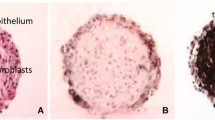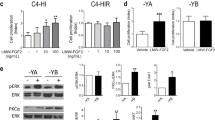Abstract
Endometrial carcinomas (EnCa) predominantly represent a steroid hormone-driven tumor initiated from prestages. The human endogenous retrovirus HERV-W envelope gene Syncytin-1 was significantly increased at the mRNA and protein levels in EnCa and prestages compared to controls. Steroid hormone treatment of primary EnCa cells and cell lines induced Syncytin-1 due to a new HERV-W estrogen response element and resulted in increased proliferation. Activation of the cAMP-pathway also resulted in Syncytin-1 upregulation, but in contrast to proliferation, classic cell–cell fusions similar to placental syncytiotrophoblasts occurred. Cell–cell fusions were also histologically identified in endometrioid EnCa tumors in vivo. Clonogenic soft agar experiments showed that Syncytin-1 is also involved in anchorage-independent colony growth as well as in colony fusions depending on steroid hormones or cAMP-activation. The posttranscriptional silencing of Syncytin-1 gene expression and a concomitant functional block of induced cell proliferation and cell–cell fusion with siRNAs proved the essential role of Syncytin-1 in these cellular processes. TGF-β1 and TGF-β3 were identified as main regulative factors, due to the finding that steroid hormone inducible TGF-β1 and TGF-β3 inhibited cell–cell fusion, whereas antibody-mediated TGF-β neutralization induced cell–cell fusions. These results showed that induced TGF-β could override Syncytin-1-mediated cell–cell fusions. Interactions between Syncytin-1 and TGF-β may contribute to the etiology of EnCa progression and also help to clarify the regulation of cell–cell fusions occurring in development and in other syncytial cell tumors.






Similar content being viewed by others
References
Ellenson LH, Wu TC (2004) Focus on endometrial and cervical cancer. Cancer Cell 5:533–538
Jemal A, Tiwari RC, Murray T et al (2004) Cancer statistics, 2004. CA Cancer J Clin 54:8–29
Sherman ME (2000) Theories of endometrial carcinogenesis: a multidisciplinary approach. Mod Pathol 13:295–308
Horn LC, Schnurrbusch U, Bilek K, Hentschel B, Einenkel J (2004) Risk of progression in complex and atypical endometrial hyperplasia: clinicopathologic analysis in cases with and without progestogen treatment. Int J Gynecol Cancer 14:348–353
Anastasiadis PG, Koutlaki NG, Skaphida PG, Galazios GC, Tsikouras PN, Liberis VA (2000) Endometrial polyps: prevalence, detection, and malignant potential in women with abnormal uterine bleeding. Eur J Gynaecol Oncol 21:180–183
Ben-Arie A, Goldchmit C, Laviv Y et al (2004) The malignant potential of endometrial polyps. Eur J Obstet Gynecol Reprod Biol 115:206–210
Emons G, Huschmand-Nia A, Krauss T, Hinney B (2004) Hormone replacement therapy and endometrial cancer. Onkologie 27:207–210
Smith DC, Prentice R, Thompson DJ, Herrmann WL (1975) Association of exogenous estrogen and endometrial carcinoma. N Engl J Med 293:1164–1167
Cuzick J, Powles T, Veronesi U et al (2003) Overview of the main outcomes in breast-cancer prevention trials. Lancet 361:296–300
Niederacher D, An HX, Camrath S et al (1998) Loss of heterozygosity of BRCA1, TP53 and TCRD markers analysed in sporadic endometrial cancer. Eur J Cancer 34:1770–1776
Chen EH, Olson EN (2005) Unveiling the mechanisms of cell–cell fusion. Science 308:369–373
Ogle BM, Cascalho M, Platt JL (2005) Biological implications of cell fusion. Nat Rev Mol Cell Biol 6:567–575
Potgens AJ, Schmitz U, Bose P, Versmold A, Kaufmann P, Frank HG (2002) Mechanisms of syncytial fusion: a review. Placenta 23:S107–S113
Bradley CS, Benjamin I, Wheeler JE, Rubin SC (1998) Endometrial adenocarcinoma with trophoblastic differentiation. Gynecol Oncol 69:74–77
Bannert N, Kurth R (2004) Retroelements and the human genome: new perspectives on an old relation. Proc Natl Acad Sci USA 101:14572–14579
Benit L, Dessen P, Heidmann T (2001) Identification, phylogeny, and evolution of retroviral elements based on their envelope genes. J Virol 75:11709–11719
Mallet F, Bouton O, Prudhomme S et al (2004) The endogenous retroviral locus ERVWE1 is a bona fide gene involved in hominoid placental physiology. Proc Natl Acad Sci USA 101:1731–1736
Yu C, Shen K, Lin M et al (2002) GCMa regulates the Syncytin-mediated trophoblastic fusion. J Biol Chem 277:50062–50068
Hashemolhosseini S, Wegner M (2004) Impacts of a new transcription factor family: mammalian GCM proteins in health and disease. J Cell Biol 166:765–768
Matouskova M, Blazkova J, Pajer P, Pavlicek A, Hejnar J (2006) CpG methylation suppresses transcriptional activity of human syncytin-1 in non-placental tissues. Exp Cell Res 312:1011–1020
Cheynet V, Ruggieri A, Oriol G et al (2005) Synthesis, assembly, and processing of the Env ERVWE1/Syncytin human endogenous retroviral envelope. J Virol 79:5585–5593
Mi S, Lee X, Li X et al (2000) Syncytin is a captive retroviral envelope protein involved in human placental morphogenesis. Nature 403:785–789
Johnston ER, Radke K (2000) The SU and TM envelope protein subunits of bovine leukemia virus are linked by disulfide bonds, both in cells and in virions. J Virol 74:2930–2935
Lavillette D, Marin M, Ruggieri A, Mallet F, Cosset FL, Kabat D (2002) The envelope glycoprotein of human endogenous retrovirus type W uses a divergent family of amino acid transporters/cell surface receptors. J Virol 76:6442–6452
Sommerfelt MA, Williams BP, McKnight A, Goodfellow PN, Weiss RA (1990) Localization of the receptor gene for type D simian retroviruses on human chromosome 19. J Virol 64:6214–6220
Derynck R, Zhang YE (2003) Smad-dependent and Smad-independent pathways in TGF-beta family signalling. Nature 425:577–584
Gold LI (1999) The role for transforming growth factor-beta (TGF-beta) in human cancer. Crit Rev Oncog 10:303–360
Parekh TV, Gama P, Wen X et al (2002) Transforming growth factor beta signaling is disabled early in human endometrial carcinogenesis concomitant with loss of growth inhibition. Cancer Res 62:2778–2790
Dowdy SC, Mariani A, Reinholz MM et al (2005) Overexpression of the TGF-beta antagonist Smad7 in endometrial cancer. Gynecol Oncol 96:368–373
Yang NN, Venugopalan M, Hardikar S, Glasebrook A (1996) Identification of an estrogen response element activated by metabolites of 17beta-estradiol and raloxifene. Science 273:1222–1225
Arici A, MacDonald PC, Casey ML (1996) Modulation of the levels of transforming growth factor beta messenger ribonucleic acids in human endometrial stromal cells. Biol Reprod 54:463–469
Strick R, Strissel PL, Gavrilov K, Levi-Setti R (2001) Cation–chromatin binding as shown by ion microscopy is essential for the structural integrity of chromosomes. J Cell Biol 155:899–910
Fearon ER, Vogelstein B (1990) A genetic model for colorectal tumorigenesis. Cell 61:759–767
Beckmann MW, Niederacher D, Bender HG (1998) Mechanisms of steroid hormone action and resistance in endometrial and breast cancer. Eur J Cancer Prev 7:S25–S28
Lalloo F, Evans G (2001) Molecular genetics and endometrial cancer. Best Pract Res Clin Obstet Gynaecol 15:355–363
Sasaki M, Dharia A, Oh BR, Tanaka Y, Fujimoto S, Dahiya R (2001) Progesterone receptor B gene inactivation and CpG hypermethylation in human uterine endometrial cancer. Cancer Res 61:97–102
Berstein LM, Tchernobrovkina AE, Gamajunova VB et al (2003) Tumor estrogen content and clinico-morphological and endocrine features of endometrial cancer. J Cancer Res Clin Oncol 129:245–249
Palmarini M, Mura M, Spencer TE (2004) Endogenous betaretroviruses of sheep: teaching new lessons in retroviral interference and adaptation. J Gen Virol 85:1–13
Wang-Johanning F, Frost AR, Johanning GL et al (2001) Expression of human endogenous retrovirus k envelope transcripts in human breast cancer. Clin Cancer Res 7:1553–1560
Menendez L, Benigno BB, McDonald JF (2004) L1 and HERV-W retrotransposons are hypomethylated in human ovarian carcinomas. Mol Cancer 3:12
Berzal Cantalejo F, Sabater Marco V, Alonso Hernandez S, Jimenez Pena R, Martorell Cebollada MA (2004) Syncytial giant cell component. Review of 55 renal cell carcinomas. Histol Histopathol 19:113–118
Vicandi B, Jimenez-Heffernan JA, Lopez-Ferrer P et al (2004) Fine needle aspiration cytology of mammary carcinoma with osteoclast-like giant cells. Cytopathology 15:321–325
Pesce C, Merino MJ, Chambers JT, Nogales F (1991) Endometrial carcinoma with trophoblastic differentiation. An aggressive form of uterine cancer. Cancer 68:1799–1802
Boyd JA, Kaufman DG (1990) Expression of transforming growth factor beta 1 by human endometrial carcinoma cell lines: inverse correlation with effects on growth rate and morphology. Cancer Res 50:3394–3399
Florini JR, Roberts AB, Ewton DZ, Falen SL, Flanders KC, Sporn MB (1986) Transforming growth factor-beta. A very potent inhibitor of myoblast differentiation, identical to the differentiation inhibitor secreted by Buffalo rat liver cells. J Biol Chem 261:16509–16513
Karsdal MA, Hjorth P, Henriksen K et al (2003) Transforming growth factor-beta controls human osteoclastogenesis through the p38 MAPK and regulation of RANK expression. J Biol Chem 278:44975–44987
Lafyatis R, Lechleider R, Roberts AB, Sporn MB (1991) Secretion and transcriptional regulation of transforming growth factor-beta 3 during myogenesis. Mol Cell Biol 11:3795–3803
Panousis CG, Evans G, Zuckerman SH (2001) TGF-beta increases cholesterol efflux and ABC-1 expression in macrophage-derived foam cells: opposing the effects of IFN-gamma. J Lipid Res 42:856–863
Niyogi K, Hildreth JE (2001) Characterization of new syncytium-inhibiting monoclonal antibodies implicates lipid rafts in human T-cell leukemia virus type 1 syncytium formation. J Virol 75:7351–7361
Alvarez-Dolado M, Pardal R, Garcia-Verdugo JM et al (2003) Fusion of bone-marrow-derived cells with Purkinje neurons, cardiomyocytes and hepatocytes. Nature 425:968–973
Kerbel RS, Lagarde AE, Dennis JW, Donaghue TP (1983) Spontaneous fusion in vivo between normal host and tumor cells: possible contribution to tumor progression and metastasis studied with a lectin-resistant mutant tumor. Mol Cell Biol 3:523–538
Duelli DM, Hearn S, Myers MP, Lazebnik Y (2005) A primate virus generates transformed human cells by fusion. J Cell Biol 171:493–503
Mangeney M, Heidmann T (1998) Tumor cells expressing a retroviral envelope escape immune rejection in vivo. Proc Natl Acad Sci USA 95:14920–14925
Acknowledgments
The authors are especially grateful to the patients who participated in this study and to the Department of Gynaecology, Erlangen. The authors wish to thank Prof. Dr. Papadopoulos at the Institute for Pathology, University of Erlangen for the histology of the tissue samples, Prof. Dr. C-M Becker (Institute for Biochemistry, University of Erlangen) for the use of the isotope laboratory, Mrs. Wenzel (Institute for Biochemistry) for cloning and sequencing, Mrs. Staerker and Toborek for hCG determinations, and Mrs. Oeser and Stiegler (Department of Gynecology) for their expert technical assistance. This study was partially supported by a grant from the DFG (#555/2-1).
Author information
Authors and Affiliations
Corresponding author
Electronic supplementary material
Below is the link to the electronic supplementary material
Supplemental Table 1
(DOC 21 kb)
Supplemental Table 2
(DOC 22 kb)
supplemental Fig. S1
Growth curves of BeWo, Kle, and RL95-2 cells in the presence of different steroid hormones, ddA or Forskolin. Open circle control, open triangle 10 nM E2, closed triangle 10 nM 4-OH-E2, closed square 1 μM estrone, cross 10 nM 2-OH-E2, closed circle 1 μM Estriol, closed diamond 10 mM ddA plus 10 nM E2, open square 500 nM progesterone, open diamond 40 μM Forskolin (JPEG 125 kb)
supplemental Fig. S2
a RT-PCR of Syncytin-1 (748 bp) and β-actin (382 bp) with RNA isolated from RL95-2 cells treated with 10 nM of either E2, 4OH-E2 (4E2), or 2OH-E2 (2E2), 1 μM estrone (E1), and 10 nM E2 plus 10 mM ddA. M DNA marker. b RT-PCR of Syncytin-1 (748 bp) and β-actin (382 bp) with RNA isolated from Syncytin-1 transfected RL95-2 cells at 4 days post transfection (c1). After 4 days post transfection the cells were cultivated for an additional 3 days (c), and treated with 10 nM E2 or 40 μM Forskolin (F) (JPEG 82 kb)
supplemental Fig. S3
Cultured BeWo cells were incubated with 10 nM E2 (E2), 40 μM SP-cAMP (SP-cAMP), 40 μM SP-cAMP plus 5 ng/ml TGF-β1 (SP-cAMP + TGF-β1), and 10 nM E2 plus 1 μg/ml anti-TGF-β1 (E2 + anti-TGF-β1), then stained with May–Grunwald and Giemsa (JPEG 211 kb)
Rights and permissions
About this article
Cite this article
Strick, R., Ackermann, S., Langbein, M. et al. Proliferation and cell–cell fusion of endometrial carcinoma are induced by the human endogenous retroviral Syncytin-1 and regulated by TGF-β. J Mol Med 85, 23–38 (2007). https://doi.org/10.1007/s00109-006-0104-y
Received:
Revised:
Accepted:
Published:
Issue Date:
DOI: https://doi.org/10.1007/s00109-006-0104-y




